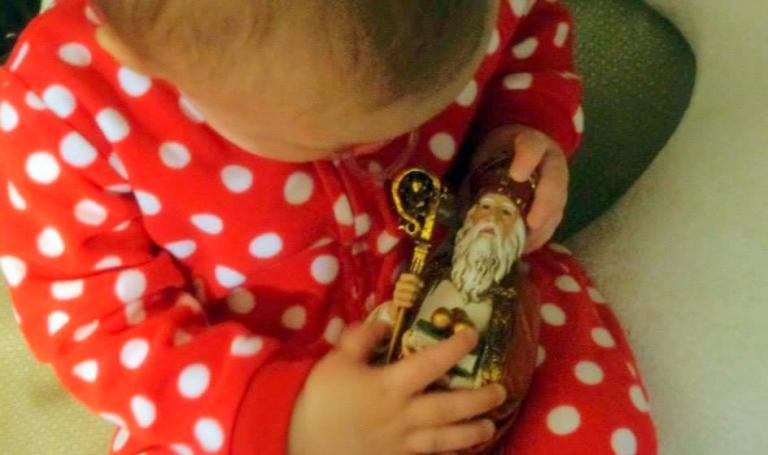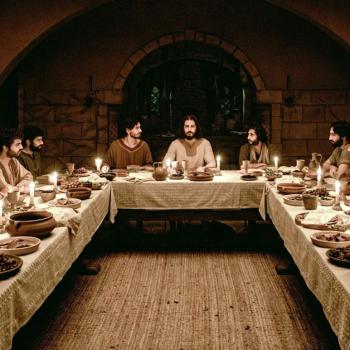 One of my Facebook friends, a young Catholic mother of small children, posted today (Dec. 8) about how she handles the debate of whether or not one should tell one’s children that Santa is real, and, how do you balance the fictional Santa Claus with the real St. Nicholas?
One of my Facebook friends, a young Catholic mother of small children, posted today (Dec. 8) about how she handles the debate of whether or not one should tell one’s children that Santa is real, and, how do you balance the fictional Santa Claus with the real St. Nicholas?
It’s tricky, because when it comes to real people, like Jesus and Mary, for example, you’d like the little ones to feel confident to take you at your word.
(For example, in the movie I recently reviewed, Netflix’s The Christmas Chronicles, being a “True Believer” in Santa is very important; Jesus is not mentioned; and the real St. Nicholas only appears in a quip by Santa Claus, played by Kurt Russell, that he prefers to be called St. Nick, but he’s not a real saint. So, there you go. Anyway …)
First, here’s a bit on Saint Nicholas, Bishop of Myra, patron saint of children, sailors, fisherman, merchants, the falsely accused, Russia and Greece.
And here’s Maria Nicki Royce’s solution to the Santa Claus/St. Nick question:
I don’t tell my children Santa is real. We pretend he is, and say things like, “When Santa visits and brings the gifts,” but they know their father and I put the gifts under the tree. They have seen big boxes delivered, for which they are sent out of the room when I open, since, “these are Christmas gifts for you.” “Can I see what it is?” “No, you will get them on the first day of Christmas.” They know the closet they are not allowed to enter because their “Santa gifts” are in it. They, too, “play Santa” when they go shopping for Christmas gifts to give to members of their family, wrap them, and put them under the tree.
Yet, they believe two days ago that Saint Nicholas put candies in their boots.
Santa Claus was a real and historic figure, however, how he is represented now is very different from who he was. “Santa Claus” isn’t the Catholic bishop saint in most American households anymore. “Santa” isn’t the one who did great deeds or taught early Christian doctrine; to most children, he is the man in the red suit who lives with elves and drives reindeer. This is an important distinction for this short essay.
Parents who don’t let their children believe in Santa say it’s because, “We don’t want to lie to our children.” A valid reason, but I believe it’s an oversimplification. I also believe it misses a valuable point.
The morning of December 6th, my 5-year -old daughter ran down the stairs, saw her boot filled with candy, gasped in shock, and said, “Saint Nicholas IS real!” That stopped me in my tracks. I even shared a little gasp in response to her. I’ve been sitting and wracking my brain trying to figure out how Saint Nicholas filling a boot was so different from Santa Claus placing gifts under a tree. I think I might now understand.
The day before his feast day, I sat with my daughter and son and told them about Saint Nicholas. They watched little videos about the things he did, and why he did them. They asked me thoughtful questions about him, and God, and good deeds. They lovingly held the little statue I have of him, while they watched videos about him, and learned about the symbols the statue held.
I explained to them the traditions of filling our shoes, and how we do it to reflect on the good deeds Saint Nicholas did in the name of Jesus Christ, out of love for God and others. I struggled with whether or not I should tell them that it was I who filled their boots, so I held back and said Saint Nicholas was performing another good deed, (even if it was through inspiring me).
When my daughter witnessed what she believed to be a miracle, performed by a saint, it confirmed in a tiny child that God and the saints are real. It confirmed in me how powerful traditions are in order to raise up good children and solidify abstract concepts
like goodness and love. It also gave this grown woman a moment to wear the shoes of a saint.
People try to say that Santa is the “Spirit of Christmas,” therefore, he is real. Maybe, in some sort of abstract way. However, I’d argue that he isn’t. on the basis of why it is argued that he is; “the spirit of giving, love,” etc., is actually the Holy Spirit, moving in us and spurring us to action. The “Christmas Spirit” isn’t mentioned by name in Scripture, and the merits which are boasted in the “Christmas Spirit” ought to exist in us all year round.
In truth, I felt more than just lied to when I found out Santa didn’t exist. I felt foolish. I felt sad, because this wonder I had clung to hadn’t been a real wonder at all. This miraculous mystery I had contemplated and put so much stock into, wasn’t worth my time, nor energy, nor admiration.
I realized, that when my children realize that Saint Nicholas didn’t fill their boots, they wouldn’t lose what I lost with Santa Claus. The saint would still be real. God would still be real. The Catholic Church would still have rich traditions, filling them with a sense of fun and adventure. The saint stories that they heard would still be the truth. The virtues they learned to extend to others would still be valuable. They will have felt the love of a saint here on earth, through the actions of their parent, standing in the shoes of a great saint, even for just a moment, and they will look forward to doing the same for their children. They will have learned of mighty deeds done in God’s name, and how even a simple mommy can pretend to be as great in order to teach her children the love of God, and His expectation to love others.
The truth they learned and felt will still be the truth. The wonder and awe will remain.
Santa Claus, how he is known today, is a fairytale. I am not against fairytales, in fact, I adore them. “Fairy tales do not tell children the dragons exist. Children already know that dragons exist. Fairy tales tell children the dragons can be killed,” – G.K. Chesterton. Fairytales convey to children the world around them in a way they can understand. Celebrating Saint Nicholas’ Day on Dec. 6 is much like explaining to children incredibly deep theological matters in a way they can understand.
In a few days, my daughter will rise before the rest of the household. She will put on her crown of candles she’s been looking at for a month. She will don a special white dress. She will make coffee and grab the rolls we will have made the night before and wake up her family members one by one. She will put on Saint Lucia. She will not grow confused, as to whether or not she has become this entity; she will still know she is herself, she’s just bringing the actions of a saint to others on earth.
Santa Claus is a fairytale. Saint Nicholas and Saint Lucia are not. I believe it is not a matter of whether or not you are “lying” to your children, so much as what truths you are imparting to them in a way they can understand and grow. Truth will always be truth, no matter if it’s denied or dressed up. My children know the red-suited Santa isn’t real, but the virtues he imparts are alive and well in their education and childhood. My children are not being denied a sense of childlike wonder, they live daily immersed in wonder of the beautiful truth of faith and God, which will always overflow any stocking.
What do you think of Maria’s idea?
Images: Courtesy Maria Nicki Royce














